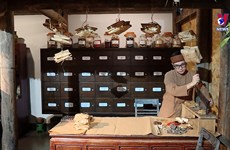Unique craft of linen weaving in Ha Giang
Linen weaving is a longstanding tradition of the H’mong ethnic minority on Dong Van karst plateau. Over time, though, the craft has been at risk of falling into oblivion. Artisan Vang Thi Mai was the first to restore the craft, and founded the Lùng Tám linen cooperative with the desire to preserve and promote the tradition.
To complete a brocade linen cloth takes 21 manual stages that require patience and meticulousness from the craftswomen. It is believed that a beautiful cloth is a measure of a woman’s talent and virtue.
With diverse textures and colours, H’mong women turn rough flax into unique and colourful products. The craft not only preserves and promotes the traditional cultural values of the ethnic minority group but also generates jobs for dozens of local women with stable incomes.
In the past, linen was often used to make clothes to wear on holidays. Now, to meet the needs of customers, it is sewn into dozens of different souvenirs such as backpacks, bags, towels, and sheets with beautiful designs.
The brocade products of the H’Mong people have followed tourists to many places at home and abroad, contributing to promoting and introducing the unique culture of ethnic minorities in Ha Giang province.
The traditional brocade and linen products from the H’Mong people in Ha Giang have been granted intellectual property rights and brand recognition and are found in 20 countries and territories around the world. This presents an opportunity and also a challenge to improve economic value and competitiveness to help the products reach out to the world./.













